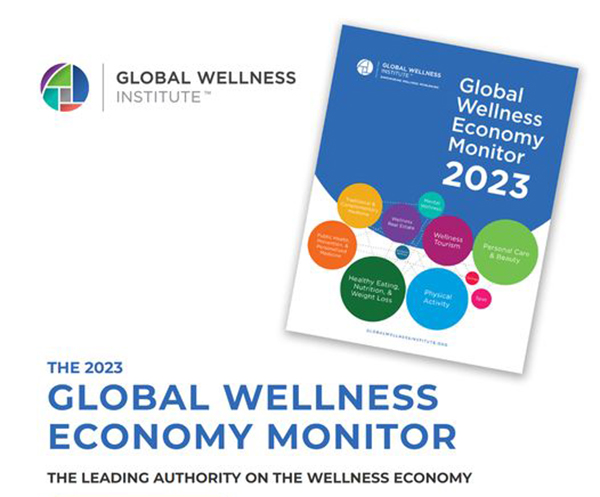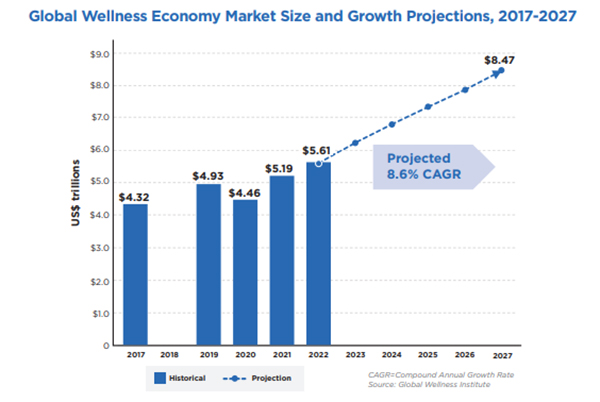New report shows global wellness economy reaches US$5.6 trillion and expected to hit US$8.5 trillion by 2027

New research unveiled by the Global Wellness Institute this week at the 17th annual Global Wellness Summit (GWS), hosted in Miami, Florida shows the global wellness economy to have reached a record-breaking US$5.6 trillion with an estimated value of US$8.5 trillion by 2027.
The GWI report - 'The Global Wellness Economy 2023' - is the 10th edition of its kind and illustrates how the market has fared since the significant economic impact of the COVID pandemic.
The report provides numbers and analyses for all 11 wellness sectors, regional data and the top 20 national markets for each wellness sector while exploring the major shifts and trends that will impact each wellness market in the future.
Katherine Johnston, GWI senior research fellow and co-author of the report shares “we’re surprised by the resiliency of the global wellness economy, and how quickly it has bounced back from the pandemic.
“If the pandemic disrupted industry momentum in the short term, it has simultaneously created a dramatic shift in the long-term opportunities and trajectory for wellness.”
Ophelia Yeung, GWI senior research fellow and paper co-author added “the global wellness economy has a strong current under its wings, based on global trends that are only accelerating: an ageing population, rising chronic diseases and mental unwellness, and a shift in consumer values.
“But it’s also facing some challenging macro conditions like widening wealth gaps, consumer confidence in uncertain economic conditions and rapidly changing geopolitics that will affect the flow of people, capital, technology and ideas. How the wellness economy will do will depend on the interplay of all of these factors.”
Like most industries, the global wellness economy has experienced major shifts and disruptions over the last few years in the wake of the COVID-19 pandemic. Prior to 2020, the wellness economy was growing strongly, and faster than overall economic growth, for many years. In 2019, the wellness economy reached $4.9 trillion. In 2020, it fell by 9.5% to $4.5 trillion, due to the pandemic.
By comparison, global GDP fell by only 2.7% in 2020. The year 2020 has become a watershed year that will forever divide history (and the wellness economy) into “before” and “after” COVID-19.
The good news is that the wellness economy has recovered quickly from the massive economic shock of 2020. Many of the 11 wellness economy sectors have recovered and now surpass their pre-pandemic levels. In 2022, the global wellness economy stands at $5.6 trillion dollars, nearly 14% higher than its size in 2019. The wellness economy grew robustly by 16.5% in 2021 in its initial phase of recovery from the pandemic, and then growth tapered off to 8.1% in 2022. By comparison, global GDP grew by 13.5% in 2021 and 4.1% in 2022.
The global wellness economy and all of the wellness sectors are poised for strong ongoing recovery and growth in the coming years, fuelled by a long-term trend of rising consumer interest in and need for wellness, which has only accelerated since the pandemic.
Seven of the 11 wellness sectors have fully recovered from the pandemic, with a 2022 market size that exceeds their 2019 level.
The GWI’s 2022 figures for the 11 sectors are as follows (in ascending order):
- Personal Care and Beauty – US$1.089 trillion (+102% on 2019)
- Healthy Eating, Nutrition and Weight Loss – US$1.079 trillion (+118% on 2019)
- Physical Activity – US$976 billion (+111% on 2019)
- Wellness Tourism – US$651 billion (+90% on 2019)
- Public Health, Prevention and Personalised Medicine – US$611 billion (+171% on 2019)
- Traditional and Complementary Medicine – US$519 billion (+107% on 2019)
- Wellness Real Estate – US$398 billion (+177% on 2019)
- Mental Wellness – US$181 billion (+139% on 2019)
- Spas – US$105 billion (+92% on 2019)
- Workplace Wellness – US$51 billion (+97% on 2019)
- Thermal / Mineral Springs – US$46 billion (+71 % on 2019)

Personal care & beauty; healthy eating, nutrition, & weight loss; and physical activity are the largest sectors in the wellness economy; together, these three sectors account for 56% of the entire global wellness market in 2022. Wellness tourism and public health, prevention, & personalised medicine comprise the rest of the top five largest sectors.
Wellness tourism, spas, and thermal/mineral springs are the wellness sectors that were most adversely affected by COVID-19, due to travel restrictions and business shutdowns. Virtual offerings are a poor substitute for a physical presence and full immersion in these experiences.
All three sectors have been growing rapidly in 2021-2022, but they have not yet recovered to their pre-pandemic levels (spas and wellness tourism remain at about 90% of their 2019 level, while springs are at 71%). A key factor in the recovery and growth of these sectors is the ongoing recovery of the global tourism market – as of 2022, international trips were still at 62% of their pre-pandemic level, and domestic trips were at 73% (according to Euromonitor data).
In addition, the Asia-Pacific region has especially lagged in its post-pandemic recovery, due to the prolonged pandemic restrictions and border closures in China, the dearth of Chinese tourists throughout the region, weakening economic conditions in China and Japan, currency depreciation, and other factors. European springs, spa, and tourism businesses have also been negatively impacted by the Ukraine war, energy prices, and staffing shortages.
Physical activity (+14.3% annual growth 2020-2022; now at 111% of its 2019 level) declined in the first year of the pandemic, but it has rebounded quickly in 2020-2022 as people started returning to their regular activities and exercise routines. Fitness was the most negatively impacted segment and has not yet returned to pre-pandemic levels, due to many factors (gym members not returning or shifting to online platforms, permanent gym closures, etc.).
Mindful movement (yoga, Pilates, etc.) saw a major boost in popularity during the pandemic and has continued to grow rapidly, not only as at-home exercise, but also for stress and mental wellness purposes. Consumer spending on sports and active recreation has also grown rapidly, although participation rates are still below their pre-pandemic levels. Supporting sectors (fitness tech, apparel/footwear, and equipment) have all been growing strongly and exceed their pre-pandemic levels.
GWI predicts that the wellness economy will continue its robust growth and expand its share of consumer spending and the global economy over the next several years. In spite of the temporary setbacks from the COVID-19 pandemic, the underlying forces that propel the growth of wellness remain as compelling as ever, including: population aging, the rise of chronic disease, the unsustainable costs of the sick-care model, widespread mental unwellness, and expanding awareness of healthy lifestyles and wellness modalities.
Wellness has expanded to encompass many more stakeholder groups beyond hospitality and recreation; it is being embraced by employers, schools, public health, urban planning, and more – and these stakeholders will increasingly take wellness to the masses.
Most of the individual wellness sectors are projected to exceed global GDP growth in the next five years. Some of the sectors with the highest growth projections (e.g., wellness tourism, thermal/ mineral springs) are those that took the greatest hit in 2020. The growth rates for these sectors may seem abnormally high because they reflect a continued period of recovery from 2023-2025, and they are then expected to taper off to a growth trajectory similar to their pre-pandemic levels.
Both the wellness tourism and spa sectors are projected to recover and exceed their pre-pandemic levels in 2023. The global thermal/mineral springs sector will take a little longer, until 2024, for a full recovery. Other sectors that maintained positive growth during the 2020 pandemic, including wellness real estate and mental wellness, are projected to continue their robust growth trends in the coming years.
GWI forecasts that four wellness sectors – personal care & beauty; healthy eating, nutrition, & weight loss; physical activity; and wellness tourism – will exceed $1 trillion in market size in 2024. They also project that three sectors will exceed half a trillion dollars in 2024: wellness real estate; traditional & complementary medicine; and public health, prevention, & personalised medicine.
They project that healthy eating, nutrition, & weight loss will become the largest segment in the wellness economy by 2025, and with its ongoing strong growth rate, wellness real estate will enter the top five sectors in the same year.
By 2027, GWI project that the global wellness economy will represent 6.6% of global GDP, as compared to 5.6% in 2022 and have an estimated value of US$8.5 trillion by 2027.
To read the full version of the report, click here.
Going forward, the GWI will release a Global Wellness Economy Report at each annual GWS.
The institute will also release Its Country Rankings Report companion research providing market size, rankings, analysis, and per capita wellness spending for 150 nations, on 30th January 2024.
Related Articles
25th October 2023 - Olympic gold-medallist Simone Biles to headline Global Wellness Summit 2023
17th October 2023 - Global Wellness Summit moved from Qatar to USA over concerns about Middle East ‘instability’
1st September 2023 - Global Wellness Institute spotlights Japan’s Wellness Economy
24th June 2023 - Qatar’s Global Wellness Summit secures sustainable tourism advocate as keynote speaker
26th May 2023 - Thailand resorts prepare to celebrate Global Wellness Day
17th May 2023 - Maldives integrated tourist destination marks Global Wellness Day with array of activities
3rd February 2023 - Global Wellness Summit report identifies 12 Wellness Trends for 2023
12th September 2022 - Global Wellness Institute spotlights Thailand’s Wellness Industry assets
19th August 2022 - Global Wellness Summit updated report spotlights trends impacting the business of wellness
12th August 2022 - Global Wellness Summit announces innovation competition for wellness in the metaverse and Web3
10th June 2022 - Global Wellness Summit spotlights latest trends in wellness metaverse
26th May 2022 - Global Wellness Institute launches country-specific Geography of Wellness microsite
3rd March 2022 - Global Wellness Summit spotlights trend of urban bathhouses
23rd December 2021 - Global wellness economy set to be worth US$7 trillion by 2025
28th October 2021 - Global Wellness Summit reports that fighting overtourism moves from talk to action
2nd September 2021 - Global Wellness Summit reports on visitation surge to fitness centres and wellness destinations
24th June 2021 - Global Wellness Institute spotlights public art and wellness trend
12th June 2021 - Fitness business experts share thoughts on the significance of Global Wellness Day
27th May 2021 - Global Wellness Institute predicts more sophisticated medical wellness destinations
6th May 2021 - Global Wellness Institute highlights rise of the ‘Nature Economy’
6th April 2021 - China-based entrepreneur and co-founder of Tianren Culture joins Global Wellness Institute Board
7th January 2021 - Global Wellness Summit highlights benefits of outdoor experiences






